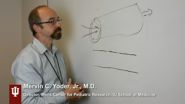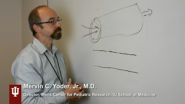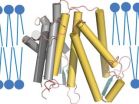(Press-News.org) VIDEO:
Researchers have developed a technique to jump-start the body's systems for creating blood vessels, opening the door for potential new treatments for diseases whose impacts include amputation and blindness....
Click here for more information.
INDIANAPOLIS -- Researchers have developed a technique to jump-start the body's systems for creating blood vessels, opening the door for potential new treatments for diseases whose impacts include amputation and blindness.
The international team, led by scientists at the Indiana University School of Medicine, is targeting new therapies for illnesses such as peripheral artery disease, a painful leg condition caused by poor blood circulation. The disease can lead to skin problems, gangrene and sometimes amputation.
While the body has cells that specialize in repairing blood vessels and creating new ones, called endothelial colony-forming cells, these cells can lose their ability to proliferate into new blood vessels as patients age or develop diseases like peripheral arterial disease, said Mervin C. Yoder Jr., M.D., Richard and Pauline Klingler Professor of Pediatrics at IU and leader of the research team.
Peripheral artery disease patients can be given medication to improve blood flow, but if the blood vessels to carry that improved flow are reduced in number or function, the benefits are minimal. If "younger," more "enthusiastic" endothelial colony forming cells could be injected into the affected tissues, they might jump-start the process of creating new blood vessels. Gathering those cells would not be easy however -- they are relatively difficult to find in adults, especially in those with peripheral arterial disease. However, they are present in large numbers in umbilical cord blood.
Reporting their work in the journal Nature Biotechnology, the researchers said they had developed a potential therapy through the use of patient-specific induced pluripotent stem cells, which are normal adult cells that have been "coaxed" via laboratory techniques into reverting into the more primitive stem cells that can produce most types of bodily tissue. So, in one of the significant discoveries reported in the Nature Biotechnology paper, the research team developed a novel methodology to mature the induced pluripotent stem cells into cells with the characteristics of the endothelial colony-forming cells that are found in umbilical cord blood. Those laboratory-created endothelial colony-forming cells were injected into mice, where they were able to proliferate into human blood vessels and restore blood flow to damaged tissues in mouse retinas and limbs.
Overcoming another hurdle that has been faced by scientists in the field, the research team found that the cord-blood-like endothelial colony-forming cells grown in laboratory tissue culture expanded dramatically, creating 100 million new cells for each original cell in a little less than three months.
"This is one of the first studies using induced pluripotent stem cells that has been able to produce new cells in clinically relevant numbers -- enough to enable a clinical trial," Dr. Yoder said. The next steps, he said, include reaching an agreement with a facility approved to produce cells for use in human testing. In addition to peripheral artery disease, the researchers are evaluating the potential uses of the derived cells to treat diseases of the eye and lungs that involve blood flow problems.
INFORMATION:
Other researchers contributing to the study were Nutan Prasain, Man Ryul Lee, Sasidhar Vemula, Jonathan Luke Meador, Momoko Yoshimoto, Michael J. Ferkowicz, Alexa Fett, Manav Gupta, Brian M. Rapp, Mohammad Reza Saadatzadeh, Michael P. Murphy and Hal E. Broxmeyer of the Indiana University School of Medicine; Michael Ginsberg, Shahin Rafii and Olivier Elemento of the Weill Cornell Medical College; Younghee Lee of the Department of Medicine, University of Chicago; Sherry L. Voytik-Harbin of the Weldon School of Biomedical Engineering, Purdue University; Hyung Min Chung of the Kon Kuk University School of Medicine, Seoul, South Korea; Ki Sung Hong of the Stem Cell Research Laboratory, CHA University, Seoul, South Korea; and Emma Reid, Christina L. O'Neill, Medina J. Reinhold and Alan W. Stitt of the Centre for Vision and Vascular Science, Queen's University Belfast, Northern Ireland.
The research was supported by funds provided by the Riley Children's Foundation; an American Heart Association postdoctoral fellowship; Public Health Service Grants R01 HL109602, RO1 HL056416, RO1 HL067384 and PO1 DK090948; and the Bio & Medical Technology Development Program of the National Research Foundation, which is funded by the South Korean government (MEST; No. 2011-0019487).
Researchers develop new cells meant to form blood vessels, treat peripheral artery disease
2014-10-12
ELSE PRESS RELEASES FROM THIS DATE:
Revving up fluorescence for superfast LEDs
2014-10-12
DURHAM, N.C. -- Duke University researchers have made fluorescent molecules emit photons of light 1,000 times faster than normal -- setting a speed record and making an important step toward realizing superfast light emitting diodes (LEDs) and quantum cryptography.
This year's Nobel Prize in physics was awarded for the discovery of how to make blue LEDs, allowing everything from more efficient light bulbs to video screens. While the discovery has had an enormous impact on lighting and displays, the slow speed with which LEDs can be turned on and off has limited their ...
Bioinspired coating for medical devices repels blood and bacteria
2014-10-12
From joint replacements to cardiac implants and dialysis machines, medical devices enhance or save lives on a daily basis. However, any device implanted in the body or in contact with flowing blood faces two critical challenges that can threaten the life of the patient the device is meant to help: blood clotting and bacterial infection.
A team of Harvard scientists and engineers may have a solution. They developed a new surface coating for medical devices using materials already approved by the Food and Drug Administration (FDA). The coating repelled blood from more ...
Atomic map reveals clues to how cholesterol is made
2014-10-12
In spite of its dangerous reputation, cholesterol is in fact an essential component of human cells. Manufactured by the cells themselves, it serves to stiffen the cell's membrane, helping to shape the cell and protect it. By mapping the structure of a key enzyme involved in cholesterol production, Rockefeller University researchers and a colleague in Italy have gained new insight into this complex molecular process.
"This is the first report to pinpoint the location of every atom — in this case nearly 3,000 of them — in one of the membrane-embedded enzymes ...
Solid nanoparticles can deform like a liquid
2014-10-12
CAMBRIDGE, Mass--A surprising phenomenon has been found in metal nanoparticles: They appear, from the outside, to be liquid droplets, wobbling and readily changing shape, while their interiors retain a perfectly stable crystal configuration.
The research team behind the finding, led by MIT professor Ju Li, says the work could have important implications for the design of components in nanotechnology, such as metal contacts for molecular electronic circuits.
The results, published in the journal Nature Materials, come from a combination of laboratory analysis and computer ...
Australian teams set new records for silicon quantum computing
2014-10-12
Two research teams working in the same laboratories at UNSW Australia have found distinct solutions to a critical challenge that has held back the realisation of super powerful quantum computers.
The teams created two types of quantum bits, or "qubits" – the building blocks for quantum computers – that each process quantum data with an accuracy above 99%. The two findings have been published simultaneously today in the journal Nature Nanotechnology.
"For quantum computing to become a reality we need to operate the bits with very low error rates," says Scientia ...
Researchers compare efficacy of 'natural' bed bug pesticides
2014-10-12
Concerns over human-insecticide exposure has stimulated the development of alternative bed bug control materials, and many essential oil-based pesticides and detergent insecticides have been developed in recent years. But how well do they work? To find out, researchers from Rutgers University evaluated the efficacy of nine essential oil-based products and two detergents that are labeled and marketed for bed bug control. The results are published in an article in the Journal of Economic Entomology.
The non-synthetic bed bug pesticides — which contain ingredients ...
Oral capsule as effective as invasive procedures for delivery of fecal transplant
2014-10-11
A noninvasive method of delivering a promising therapy for persistent Clostridium difficile (C. difficile) infection appears to be as effective as treatment via colonoscopy or through a nasogastric tube. In their JAMA report, receiving early online release to coincide with a presentation at the Infectious Diseases Society of America's ID Week conference, investigators from Massachusetts General Hospital (MGH) report that oral administration of the therapy called fecal microbiota transplant (FMT) in acid-resistant capsules was as successful as more invasive methods in eliminating ...
Treating C. diff infection with oral, frozen encapsulated fecal material
2014-10-11
A preliminary study has shown the potential of treating recurrent Clostridium difficile infection (a bacterium that is one of the most common causes of infection of the colon) with oral administration of frozen encapsulated fecal material from unrelated donors, which resulted in an overall rate of resolution of diarrhea of 90 percent, according to a study published in JAMA. The study is being released early online to coincide with its presentation at IDWeek 2014.
Recurrent Clostridium difficile infection (CDI) is a major cause of illness and death, with a recent increase ...
Body contouring after bariatric surgery helps obese patients keep the weight off
2014-10-11
DETROIT – Patients who have plastic surgery to reshape their bodies after bariatric procedures are able to maintain "significantly greater" weight loss than those who do not have surgery, according to a new study by Henry Ford Hospital researchers.
"As plastic and reconstructive surgeons, we are encouraged by the idea that improved body image can translate into better long-term maintenance of a healthier weight, and possibly a better quality of life for our patients," says Donna Tepper, M.D., a Henry Ford plastic surgeon and senior author of the study.
Study results ...
New cough study demonstrates diphenhydramine to inhibit cough reflex with Dr. Cocoa form
2014-10-11
SAN DIEGO, CA, October 11, 2014 – Cough is among the most common complaints for which patients seek medical attention. Leading cough researcher Peter V. Dicpinigaitis, M.D., Professor of Clinical Medicine at New York's Albert Einstein College of Medicine, recently conducted a new cough challenge study among adults, whose results were first presented at the European Respiratory Society International Congress in September 2014. The study was conducted using 22 adults with acute URI (common cold) who underwent cough reflex sensitivity measurement employing capsaicin ...




